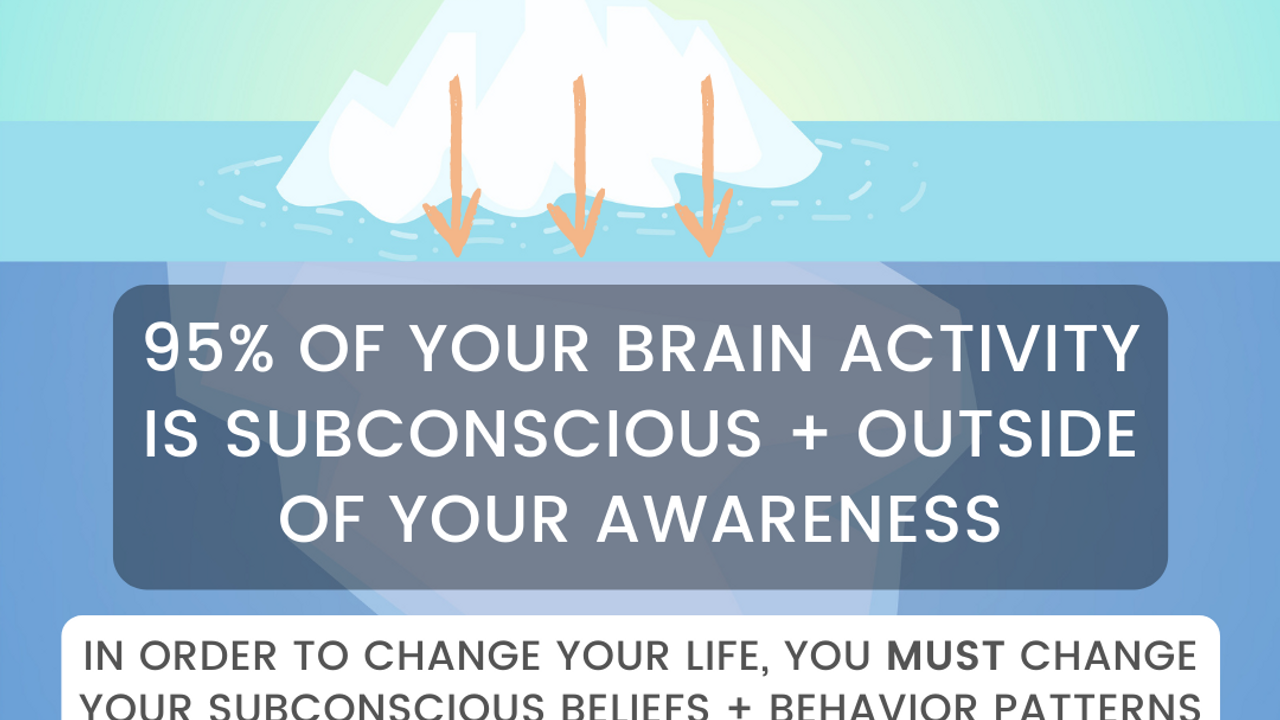Reprogram Your Mind: How to Master the Subconscious and Conscious

Did you know that 95% of your brain activity is subconscious and outside of your awareness? That’s right—most of the time, we’re running on autopilot, repeating the same thoughts, habits, and behaviors day in and day out. Only 5% of the time are we consciously aware of our thoughts and actions as they occur.
Understanding the difference between your subconscious and conscious mind is the key to unlocking personal growth and breaking free from limiting patterns. Let’s explore these two aspects of your mind and how you can harness their power to transform your life.
The Conscious Mind
The conscious mind is like the tip of the iceberg, making up only 5% of your mental activity. It’s the part of your mind that is actively aware, responsive, and capable of processing information in real-time. This is where you experience deliberate thoughts and actions—the choices you make when you’re fully present in the moment.
One of the most important roles of the conscious mind is its ability to influence and reprogram the subconscious mind. However, most people live almost entirely on autopilot because they are unaware of the subconscious patterns driving their behaviors.
To start reprogramming your subconscious, you must first bring awareness to your body and emotions. This means:
-
Dropping into Your Body: When triggered, don’t focus solely on your thoughts. Instead, tune into your physical sensations.
-
Observing Your State: Identify how you’re feeling and where in your body you feel it. Is your nervous system heightened? Is your breathing shallow?
-
Regulating Your Body: Practice slow, deep breathing to calm your nervous system and bring your mind and body back into alignment.
By learning to respond consciously rather than reacting unconsciously, you weaken the hold of trauma response patterns and teach your body to stay grounded in the present.
The Subconscious Mind
The subconscious mind operates like a computer program, running automatically and making up 95% of your brain activity. It stores all your memories, beliefs, and habitual behaviors, often without your conscious awareness. This is where deeply ingrained patterns and reactions live.
Here are a few key characteristics of the subconscious mind:
-
Automatic Functioning: The subconscious influences your actions, even when you’re not actively thinking about them.
-
Literal Interpretation: It cannot process negatives or distinguish between real and imagined events, accepting everything as absolute truth.
-
Formative Conditioning: During your early years (ages 0-7), your subconscious mind absorbed information automatically, shaping your beliefs and values based on your environment and caregivers.
The subconscious mind’s primary goal is to keep you safe. It clings to familiar patterns and habits, even if they no longer serve you, because it equates familiarity with survival. This is why it’s so challenging to break free from limiting cycles.
Breaking Free from Subconscious Conditioning
From age 8 onward, your subconscious mind begins reinforcing the beliefs and habits of your early environment. You start to see the world through the lens of your caregivers and societal conditioning, which impacts how you perceive yourself and others.
As long as your worth and identity are tied to external factors, your subconscious will continue reacting to the outside world, keeping you in a disempowered state. This often leads to feelings of unease, stress, and low vibrational energy.
The good news is that your brain has the ability to change through neuroplasticity—the formation of new neural pathways. Here’s how you can start reprogramming your subconscious:
-
Recognize Patterns: Begin by observing the repetitive thoughts, emotions, and behaviors that no longer serve you.
-
Question Beliefs: Ask yourself where these patterns came from and whether they align with your true self.
-
Reframe Your Narrative: Replace limiting beliefs with empowering ones. For example, transform “I’m not good enough” into “I am capable and deserving.”
-
Practice Consistently: Repetition is crucial for creating new neural pathways. Regularly engage in affirmations, visualization, and mindful practices.
-
Embrace Discomfort: Growth requires stepping outside your comfort zone. Lean into the unfamiliar to build resilience and expand your potential.
The Connection Between Mind and Body
Your body and mind are deeply interconnected. Anytime you feel yourself reacting to a situation, it’s a sign that your subconscious mind is at work. Instead of spiraling into overthinking, drop into your body and notice:
-
Physical Sensations: What are you feeling, and where do you feel it?
-
Emotional States: What emotions are surfacing?
-
Breathing Patterns: Is your breath shallow or steady?
Slowing your breath and calming your nervous system allows you to break the reactive cycle and respond with intention. This practice not only helps you reprogram your subconscious but also fosters a deeper connection with your authentic self.
Final Thoughts
Your subconscious mind is a powerful force, but it’s not your master. By bringing conscious awareness to your thoughts, emotions, and behaviors, you can break free from limiting patterns and create a life aligned with your true desires.
Remember, the journey to transformation begins with awareness. Take the time to observe your inner world, question old beliefs, and step into the power of conscious living. The more you practice, the more empowered and aligned you will feel.
Work with us

Do you experience high stress and anxiety?
Want to learn how to regulate your nervous system?
Good news! We will soon be taking on 1:1 clients for our Heal Your Inner Child
6-week coaching program.

